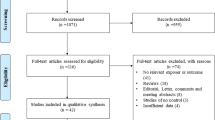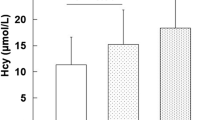Abstract
Purpose
Pseudoexfoliation syndrome (PEX) is a late onset disorder of extracellular matrix turnover, associated systemically with cardiovascular and cerebrovascular disease. To evaluate the suggested association of polymorphisms of homocysteine metabolism genes MTHFR (rs1801131, rs1801133) and MTHFD1 (rs8006686) with PEX.
Methods
A case–control association study was undertaken, comprising a total of 1472 individuals including 860 unrelated PEX cases and 612 ethnic-matched cataract controls (CC). All the study subjects were genotyped for three SNPs using the TaqMan allelic discrimination assay. Association and statistical analysis were performed with PLINK 1.07 and STATA 11.1.
Results
Among the three SNPs genotyped, MTHFR polymorphisms did not exhibit significant association with PEX (rs1801131; p = 0.549, rs1801133; p = 0.408). The intronic SNP rs8006686 showed nearly significant association (p = 0.069), and however did not remain significant after Bonferroni correction.
Conclusion
Our study suggests no significant genetic association of MTHFR (rs1801131, rs1801133) and MTHFD1 (rs8006686) polymorphisms in South Indian PEX patients.
Similar content being viewed by others
References
Lindberg JG (1917) Clinical studies of depigmentation of the pupillary margin and transillumination of the iris in cases of senile cataract and also in normal eyes in the aged. Thesis, Helsinki University, Helsinki
Quigley HA (1996) Number of people with glaucoma worldwide. Br J Ophthalmol 80(5):389–393
Ritch R, Schlötzer-Schrehardt U (2001) Exfoliation syndrome. Surv Ophthalmol 45(4):265–315
Elhawy E, Kamthan G, Dong CQ, Danias J (2012) Pseudoexfoliation syndrome, a systemic disorder with ocular manifestations. Hum Genomics 6(1):1
Arvind H, Raju P, Paul PG, Baskaran M, Ramesh SV, George RJ, Vijaya L (2003) Pseudoexfoliation in south India. Br J Ophthalmol 87(11):1321–1323
Krishnadas R, Nirmalan PK, Ramakrishnan R, Thulasiraj RD, Katz J, Tielsch JM, Robin AL (2003) Pseudoexfoliation in a rural population of southern India: the Aravind Comprehensive Eye Survey. Am J Ophthalmol 135(6):830–837
Thomas R, Nirmalan PK, Krishnaiah S (2005) Pseudoexfoliation in southern India: the Andhra Pradesh Eye Disease Study. Invest Ophthalmol Vis Sci 46(4):1170–1176
Ritch R (1994) Exfoliation syndrome-the most common identifiable cause of open-angle glaucoma. J Glaucoma 3(2):176–177
Allingham RR, Loftsdottir M, Gottfredsdottir MS, Thorgeirsson E, Jonasson F, Sverisson T, Stefánsson E (2001) Pseudoexfoliation syndrome in Icelandic families. Br J Ophthalmol 85(6):702–707
Hardie JG, Mercieca F, Fenech T, Cuschieri A (2005) Familial pseudoexfoliation in Gozo. Eye 19(12):1280–1285
Lemmela S, Forsman E, Sistonen P, Eriksson A, Forsius H, Järvelä I (2007) Genome-wide scan of exfoliation syndrome. Invest Ophthalmol Vis Sci 48(9):4136–4142
Lievers KJ, Kluijtmans LA, Blom HJ (2003) Genetics of hyperhomocysteinemia in cardiovascular disease. Ann Clin Biochem 40(1):46–59
van der Put NM, Gabreëls F, Stevens EM, Smeitink JA, Trijbels FJ, Eskes TK, Blom HJ (1998) A second common mutation in the methylenetetrahydrofolate reductase gene: an additional risk factor for neural-tube defects? Am J Hum Genet 62(5):1044–1051
Frosst P, Blom HJ, Milos R, Goyette P, Sheppard CA, Matthews RG, Boers GJH, den Heijer M, Kluijtmans LAJ, van den Heuvel LP, Rozen R (1995) A candidate genetic risk factor for vascular disease: a common mutation in methylenetetrahydrofolate reductase. Nat Genet 10(1):111–113
Lalouschek W, Aull S, Serles W, Wolfsberger M, Deecke L, Pabinger-Fasching I, Mannhalter C (2000) The relation between erythrocyte volume and folate levels is influenced by a common mutation in the methylenetetrahydrofolate reductase (MTHFR) gene (C.665C>T). J Invest Med 48(1):14–20
Weisberg I, Tran P, Christensen B, Sibani S, Rozen R (1998) A second genetic polymorphism in methylenetetrahydrofolate reductase (MTHFR) associated with decreased enzyme activity. Mol Genet Metab 64(3):169–172
Miller SA, Dykes DD, Polesky HFRN (1988) A simple salting out procedure for extracting DNA from human nucleated cells. Nucleic Acids Res 16(3):1215
Purcell S, Neale B, Todd-Brown K, Thomas L, Ferreira MA, Bender D, Sham PC (2007) PLINK: a tool set for whole-genome association and population-based linkage analyses. Am J Hum Genet 81(3):559–575
Ritch R (2016) Systemic associations of exfoliation syndrome. Asia-Pac J Ophthalmol 5(1):45–50
Kang JH, Wiggs JL, Pasquale LR (2014) Relation between time spent outdoors and exfoliation glaucoma or exfoliation glaucoma suspect. Am J Ophthalmol 158(3):605–614
Pasquale LR, Jiwani AZ, Zehavi-Dorin T, Majd A, Rhee DJ, Chen T, Gardiner M (2014) Solar exposure and residential geographic history in relation to exfoliation syndrome in the United States and Israel. JAMA Ophthalmol 132(12):1439–1445
Stein JD, Pasquale LR, Talwar N, Kim DS, Reed DM, Nan B, Richards JE (2011) Geographic and climatic factors associated with exfoliation syndrome. Arch Ophthalmol 129(8):1053–1060
Pasquale LR, Wiggs JL, Willett WC, Kang JH (2012) The relationship between caffeine and coffee consumption and exfoliation glaucoma or glaucoma suspect: a prospective study in two cohorts relationship between caffeine and exfoliation glaucoma. Invest Ophthalmol Vis Sci 53(10):6427–6433
Thorleifsson G, Magnusson KP, Sulem P, Walters GB, Gudbjartsson DF, Stefansson H, Masson G (2007) Common sequence variants in the LOXL1 gene confer susceptibility to exfoliation glaucoma. Science 317(5843):1397–1400
Aung T, Ozaki M, Mizoguchi T, Allingham RR, Li Z, Haripriya A, Lee MC (2015) A common variant mapping to CACNA1A is associated with susceptibility to exfoliation syndrome. Nat Genet 47(4):387–392
Dubey SK, Hejtmancik JF, Krishnadas SR, Sharmila R, Haripriya A, Sundaresan P (2014) Lysyl oxidase-like 1 gene in the reversal of promoter risk allele in pseudoexfoliation syndrome. JAMA Ophthalmol 132(8):949–955
Angeline T, Jeyaraj N, Granito S, Tsongalis GJ (2004) Prevalence of MTHFR gene polymorphisms (C.665C>T and C.1286A>C) among Tamilians. Exp Mol Pathol 77(2):85–88
Dayakar S, Goud KI, Reddy TPK, Rao SP, Sesikeran SB, Sadhnani M (2011) Sequence variation of the methylene tetrahydrofolate reductase gene (677C>T and 1298 A>C) and traditional risk factors in a South Indian population. Genetic testing and molecular biomarkers 15(11):765–769
Kumar J, Das SK, Sharma P, Karthikeyan G, Ramakrishnan L, Sengupta S (2005) Homocysteine levels are associated with MTHFR C.1286A>C polymorphism in Indian population. J Hum Genet 50(12):655–663
Mukherjee M, Joshi S, Bagadi S, Dalvi M, Rao A, Shetty KR (2002) A low prevalence of the C.665C>T mutation in the methylenetetrahydrofolate reductase gene in Asian Indians. Clin Genet 61(2):155–159
Leibovitch I, Kurtz S, Shemesh G, Goldstein M, Sela BA, Lazar M, Loewenstein A (2003) Hyperhomocystinemia in pseudoexfoliation glaucoma. J Glaucoma 12(1):36–39
Vessani RM, Ritch R, Liebmann JM, Jofe M (2003) Plasma homocysteine is elevated in patients with exfoliation syndrome. Am J Ophthalmol 136(1):41–46
Bleich S, Roedl J, Von Ahsen N, Schlötzer-Schrehardt U, Reulbach U, Beck G, Jünemann AG (2004) Elevated homocysteine levels in aqueous humor of patients with pseudoexfoliation glaucoma. Am J Ophthalmol 138(1):162–164
Puustjärvi T, Blomster H, Kontkanen M, Punnonen K, Teräsvirta M (2004) Plasma and aqueous humour levels of homocysteine in exfoliation syndrome. Graefe’s Arch Clin Exp Ophthalmol 242(9):749–754
Altintaş Ö, Maral H, Yüksel N, Karabaş VL, Dillioğlugil MÖ, Çağlar Y (2005) Homocysteine and nitric oxide levels in plasma of patients with pseudoexfoliation syndrome, pseudoexfoliation glaucoma, and primary open-angle glaucoma. Graefe’s Arch Clin Exp Ophthalmol 243(7):677–683
Cumurcu T, Sahin S, Aydin E (2006) Serum homocysteine, vitamin B 12 and folic acid levels in different types of glaucoma. BMC Ophthalmol 6(1):1
Saricaoglu S, Karakurt A, Sengun A, Hasiripi H (2006) Plasma homocysteine levels and vitamin B status in patients with pseudoexfoliation syndrome. Saudi Med J 27(6):833–837
Turgut B, Kaya M, Arslan S, Demir T, Güler M, Kaya MK (2010) Levels of circulating homocysteine, vitamin B6, vitamin B12, and folate in different types of open-angle glaucoma. Clin Interv Aging 5:133
Türkcü FM, Köz OG, Yarangümeli A, Oner V, Kural G (2012) Plasma homocysteine, folic acid, and vitamin B12 levels in patients with pseudoexfoliation syndrome, pseudoexfoliation glaucoma, and normotensive glaucoma. Medicina (Kaunas, Lithuania) 49(5):214–218
Yaghoubi G, Heydari B, Raza MM, Zohre B (2007) Homocysteine levels in plasma of cataract patients with and without pseudoexfoliation syndrome. Middle East Afr J Ophthalmol 14(1):22
Vardhan A et al (2016) Serum homocysteine levels in Indian patients with ocular pseudoexfoliation. US-ARVO abstract, poster no: 1988-B0068
Bleich S, Jünemann A, Von Ahsen N, Lausen B, Ritter K, Beck G, Kornhuber J (2002) Homocysteine and risk of open-angle glaucoma. J Neural Transm 109(12):1499–1504
Jünemann AG, von Ahsen N, Reulbach U, Roedl J, Bönsch D, Kornhuber J, Bleich S (2005) C.665C>T variant in the methylentetrahydrofolate reductase gene is a genetic risk factor for primary open-angle glaucoma. Am J Ophthalmol 139(4):721–723
Turaçli ME, Tekeli O, Özdemir F, Akar N (2005) Methylenetetrahydrofolate reductase 677 C–T and homocysteine levels in Turkish patients with pseudoexfoliation. Clin Exp Ophthalmol 33(5):505–508
Mossbock G, Weger M, Faschinger C, Steinbrugger I, Temmel W, Schmut O, Stanger O (2006) Methylenetetrahydrofolatereductase (MTHFR) 677C>T polymorphism and open angle glaucoma. Mol Vis 12:356–359
Roedl JB, Bleich S, Reulbach U, Rejdak R, Naumann GOH, Kruse FE, Jünemann AGM (2007) Vitamin deficiency and hyperhomocysteinemia in pseudoexfoliation glaucoma. J Neural Transm 114(5):571–575
DelBono E, Haines JL, Fan B, Chen TCC, Grosskreutz CL, Pasquale L, Wiggs JL (2008) Lack of association of polymorphisms in homocysteine metabolism genes with pseudoexfoliation syndrome and glaucoma
Talebnejad MR, Mosallaei M, Azarpira N (2009) Methylenetetrahydrofolate reductase gene polymorphism and homocysteine level in patients with pseudoexfoliation and pseudoexfoliation glaucoma in southern Iran. Iran Red Crescent Med J 11(4):445
Nilforoushan N, Aghapour S, Raoofian R, Rad SS, Greene WK, Fakhraie G, Heidari M (2012) Lack of association between the C.665C>T single nucleotide polymorphism of the MTHFR gene and glaucoma in Iranian patients. Acta Med Iran 50(3):208
Clement CI, Goldberg I, Healey PR, Graham SL (2009) Plasma homocysteine, MTHFR gene mutation, and open-angle glaucoma. J Glaucoma 18(1):73–78
Woo SJ, Kim JY, Kim DM, Park SS, Ko HS, Yoo T (2009) Investigation of the association between 677C>T and 1298A>C 5, 10-methylenetetra-hydrofolate reductase gene polymorphisms and normal-tension glaucoma. Eye 23(1):17–24
Xu F, Zhang L, Li M (2012) Plasma homocysteine, serum folic acid, serum vitamin B12, serum vitamin B6, MTHFR and risk of pseudoexfoliation glaucoma: a meta-analysis. Graefe’s Arch Clin Exp Ophthalmol 250(7):1067–1074
Zacharaki F, Hadjigeorgiou GM, Koliakos GG, Morrison MA, Tsezou A, Chatzoulis DZ, DeAngelis MM (2014) Plasma homocysteine and genetic variants of homocysteine metabolism enzymes in patients from Central Greece with primary open-angle glaucoma and pseudoexfoliation glaucoma. Clin Ophthalmol (Auckland NZ) 8:1819
Cardon LR, Bell JI (2001) Association study designs for complex diseases. Nat Rev Genet 2(2):91–99
Acknowledgements
The authors thank all the patients for their kind cooperation in this study. We like to express our gratitude to Mr. Vijayakumar, Biostatistician, Aravind Eye Hospital for his assistance on statistical analysis. We also thank Mr. Saravanan, Senior Technician and lab coordinators: Mrs. Kalarani, Mrs. Muthuselvi for their kind help during genotyping experiment and sample collection, respectively.
Author information
Authors and Affiliations
Corresponding author
Ethics declarations
Conflict of interest
The authors declare no financial or proprietary interest in any of the methods or materials discussed in this manuscript.
Ethical approval
All the procedures performed in this study involving human participants were in accordance with the ethical standards of the Institutionary Ethics Committee of Aravind Eye Hospital and with 1964 Helsinki Declaration and its amendments or comparable ethical standards.
Funding
This study was financially supported by the Alcon APEX-Aravind Eye Hospital project.
Informed consent
Written informed consent was obtained from all the individual participants included in this study.
Rights and permissions
About this article
Cite this article
Gopalakrishnan, P., Haripriya, A. & Sundaresan, P. MTHFR and MTHFD1 gene polymorphisms are not associated with pseudoexfoliation syndrome in South Indian population. Int Ophthalmol 38, 599–606 (2018). https://doi.org/10.1007/s10792-017-0498-2
Received:
Accepted:
Published:
Issue Date:
DOI: https://doi.org/10.1007/s10792-017-0498-2




